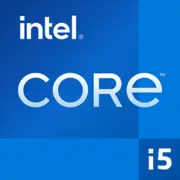Intel Core i5-1350P

Intel Core i5-1350P: A Balance of Performance and Mobility in 2025
March 2025
Modern laptops require processors to provide not only speed but also energy efficiency. The Intel Core i5-1350P, introduced in 2023, remains a relevant solution for users in need of a versatile device. Let's explore why this chip continues to compete with AMD and Apple’s latest offerings, and who it is suitable for in 2025.
Architecture and Process Technology: Hybrid Cores and Next-Level Graphics
The i5-1350P processor belongs to the Raptor Lake generation and is manufactured using Intel's 7 process (equivalent to 10nm Enhanced SuperFin). Its key feature is a hybrid architecture that divides into performance (P-core) and energy-efficient (E-core) cores:
- 12 cores: 4 P-cores (Golden Cove) with Hyper-Threading (8 threads) + 8 E-cores (Gracemont) without multithreading.
- Base frequency: 1.9 GHz (P-core), 1.4 GHz (E-core).
- Turbo Boost: up to 4.6 GHz for P-cores, 3.5 GHz for E-cores.
- Cache: 12 MB L3.
Integrated graphics Iris Xe (96 EU) support 4K displays, AV1 encoding, and can achieve up to 60 FPS in games like CS:2 or Rocket League at low settings. For office tasks and video editing in Full HD resolution, it is sufficient, but for AAA games, a discrete graphics card will be required.
Power Consumption and TDP: Power Management
The TDP of the processor is 28W, which is typical for ultrabooks and thin work laptops. However, in Turbo Boost mode, power can briefly reach 64W. This necessitates a quality cooling system; otherwise, throttling may occur.
Energy-saving technologies:
- Intel Dynamic Tuning 3.0: automatically adjusts power based on workload.
- Core undervolting: supported through utilities like ThrottleStop.
Practically, this means that while browsing or using Word, the processor consumes 5-8W, while during video rendering, it can consume up to 28W.
Performance: Faster Than It Appears
Geekbench 6:
- Single-Core: 2194 (comparable to Ryzen 7 7840U).
- Multi-Core: 8684 (on par with Apple M2).
Real-world scenarios:
- Office tasks: Simultaneous work with 30+ tabs in Chrome, Excel sheets, and Zoom—without lag.
- Multimedia: Converting a 1-hour video in HandBrake (H.265) takes ~12 minutes.
- Gaming: Genshin Impact on medium settings (1080p) achieves 40-45 FPS.
Turbo Boost mode activates when 1-2 cores are under load (e.g., in Photoshop). However, if all cores are engaged (as in rendering), the frequency of the P-core drops to 3.8 GHz after 2-3 minutes due to heat.
Usage Scenarios: Who is the i5-1350P Designed For?
- Students and office workers: Multitasking + autonomy.
- Freelancers: Light video editing, working in Figma or Blender (medium complexity projects).
- Travelers: Thin laptops weighing up to 1.5 kg (e.g., Dell XPS 13 or Lenovo Yoga Slim 7).
Not suitable for:
- Gamers expecting 100+ FPS in Cyberpunk 2077.
- Engineers working with 3D models in SolidWorks.
Battery Life: How Long Will the Battery Last?
With a battery capacity of 60 Wh:
- Web surfing: 8-10 hours.
- 4K video: 6-7 hours.
- Load (Photoshop + Chrome): 3-4 hours.
Power-saving options:
- Disabling E-cores in BIOS settings (increases runtime by 15%, but reduces multithreaded performance).
- "Power Saving" mode in Windows 12: limits the frequency to 2.5 GHz.
Comparison with Competitors: Who Does the i5-1350P Outperform?
- AMD Ryzen 5 7640U (Zen 4): Better in multithreaded tasks (+10% in Cinebench R23), but weaker in single-threaded (-7%). Laptop prices are comparable ($900-$1100).
- Apple M2: Higher battery life (up to 12 hours) and speed in "native" applications (Final Cut Pro), but limited compatibility with Windows software.
- Intel Core i5-1250P (Alder Lake): The i5-1350P is 12% faster in multitasking due to optimized E-cores.
Pros and Cons
Strengths:
- Ideal for office work and education.
- Support for Thunderbolt 4 and Wi-Fi 6E.
- Affordable laptop prices (starting from $800).
Weaknesses:
- Noisy fans under load.
- Heating up to 95°C in Turbo mode.
- Lack of PCIe 5.0 support.
Laptop Selection Recommendations
1. Device type: Ultrabooks (ASUS ZenBook 14) or business laptops (HP EliteBook 840 G10).
2. Cooling: Look for models with dual fans and copper pipes (e.g., Lenovo ThinkPad T14s).
3. Display: IPS screen with 300 nits and 100% sRGB (important for designers).
4. Battery: At least 60 Wh.
5. Memory and SSD: 16 GB DDR5 + 512 GB NVMe (upgrading is better done right away as many ultrabooks do not have RAM slots).
The average price of laptops with the i5-1350P in 2025 is $850–$1200.
Final Conclusion
The Intel Core i5-1350P is a successful choice for those seeking a balance between performance, portability, and price. It can handle everyday tasks, light creativity, and even casual gaming. However, for professional work with 3D models or streaming, it is better to consider models with H-series processors (e.g., i7-13700H) or Ryzen 7 7840HS.
Who is it suitable for:
- Students.
- Office employees.
- Freelancers in design and editing.
- Users who value quiet operation and long battery life.
If your budget is limited to $1000, the i5-1350P remains one of the best options in 2025.
Basic
CPU Specifications
Memory Specifications
GPU Specifications
Miscellaneous
Benchmarks
Compared to Other CPU
Share in social media
Or Link To Us
<a href="https://cputronic.com/cpu/intel-core-i5-1350p" target="_blank">Intel Core i5-1350P</a>